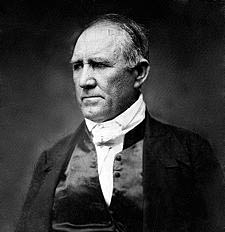
(March 2, 1793 – July 26, 1863)
Samuel Houston was a 19th century American statesman, politician, and soldier.
He was born in Lexington, Virginia, in 1793 and was the son of a career Army officer and veteran of the Revolutionary War. The family moved to Tennessee farm in 1807, and as a teenager Houston began his lifelong association with the Cherokee Indians who were located along the Tennessee river, and learned their language and culture.
At 20-years old he joined the 7th Infantry Regiment and went with Andrew Jackson in his campaign against the Creek Indians in Alabama. He earned a commission as a Lieutenant, distinguishing himself in the battle of Horseshoe Bend. However, suffering arrow and gunshot wounds, he resigned from the Army after the war, and in 1818 finished Law School and passed the bar.
Andrew Jackson was now his friend and benefactor and helped him get elected to public office. He later served two terms in Congress and helped elect Jackson president. Jackson then helped Houston become governor of Tennessee.
In 1829 Houston married Eliza Allen, the daughter of a rich Tennessee family, but the marriage only lasted three months, the despondent Houston resigned the governorship and drifted to Arkansas where he lived among the Cherokees, starting a trading post and taking up with a Cherokee woman. As a spokesman for the Cherokees, he traveled to Washington on Indian business.
In 1832 he went to Texas for the first time, some even say as an “unofficial” mission for president Jackson, and reported that the people in Texas were favorably disposed to becoming part of the United States. He settled in Nacogdoches, opened his Law practice and became involved in the movement for Texas independence. In 1835, with a Texas revolution against Mexico now a sure thing, Houston was elected chief of his district and began raising a volunteer force. Later in November he was named Commander-in-Chief of the Texas Army.
With Santa Anna’s army approaching the Rio Grande in February of 1836, Houston attempted to have the Alamo’s cannon removed and the defenses torn down, but on March 6, Santa Anna attacked and all of the 183 defenders were killed, including Houston’s friend Jim Bowie. He also received word of the loss of Fannin’s force at Goliad.
Houston maneuvered and played for time to get his poorly trained recruits in fighting shape, which some, if not most of those around him, and the acting president of Texas, Davis Burnet, thought him afraid to fight, and urged him to do so. Houston craftily played for time, and knew Santa Anna’s movements due to his trusted scouts following the Mexican army.
They told him that Santa Anna’s army was camped on the San Jacinto River and that he had almost no “pickets” (soldiers out from the main body to warn of surprise attack) so Houston’s Army numbering 783 men threw themselves against Santa Anna’s 1500 man force with shouts of “Remember Goliad, and Remember the Alamo” the battle itself was a total defeat for the Mexicans. Almost half were killed and the other half were taken prisoner, including Santa Anna trying to hide in a private’s uniform. This was the battle that freed Texas, and Sam Houston was elected its first president. He quickly secured United States recognition for Texas.
In 1840, Houston married Margaret Moffette Lea of Alabama (they had eight children together) and served two terms as president of Texas. In 1846 Texas was annexed as a state, and Houston served as a Senator for 14 years. He opposed secession, resisted joining the Confederacy and refused to swear allegiance to it, so as a result the Texas legislature declared the office of governor vacant and Houston retired to his farm in Huntsville Texas and died July 26, 1863.





